FRIDAY, DECEMBER 16
■ The little Pleiades cluster shines high in the southeast after dinnertime, upper right of Mars by about a fist at arm's length, as shown below. It's the size of your fingertip at arm's length. Its six brightest stars form a miniature dipper standing on its handle.
How many Pleiads can you count with your unaided eye? Take your time and keep looking. Most people with good vision can count those 6. But with sharper eyesight, a good dark sky, and a steady gaze, you may make out 8 or 9. Binoculars show several dozen.
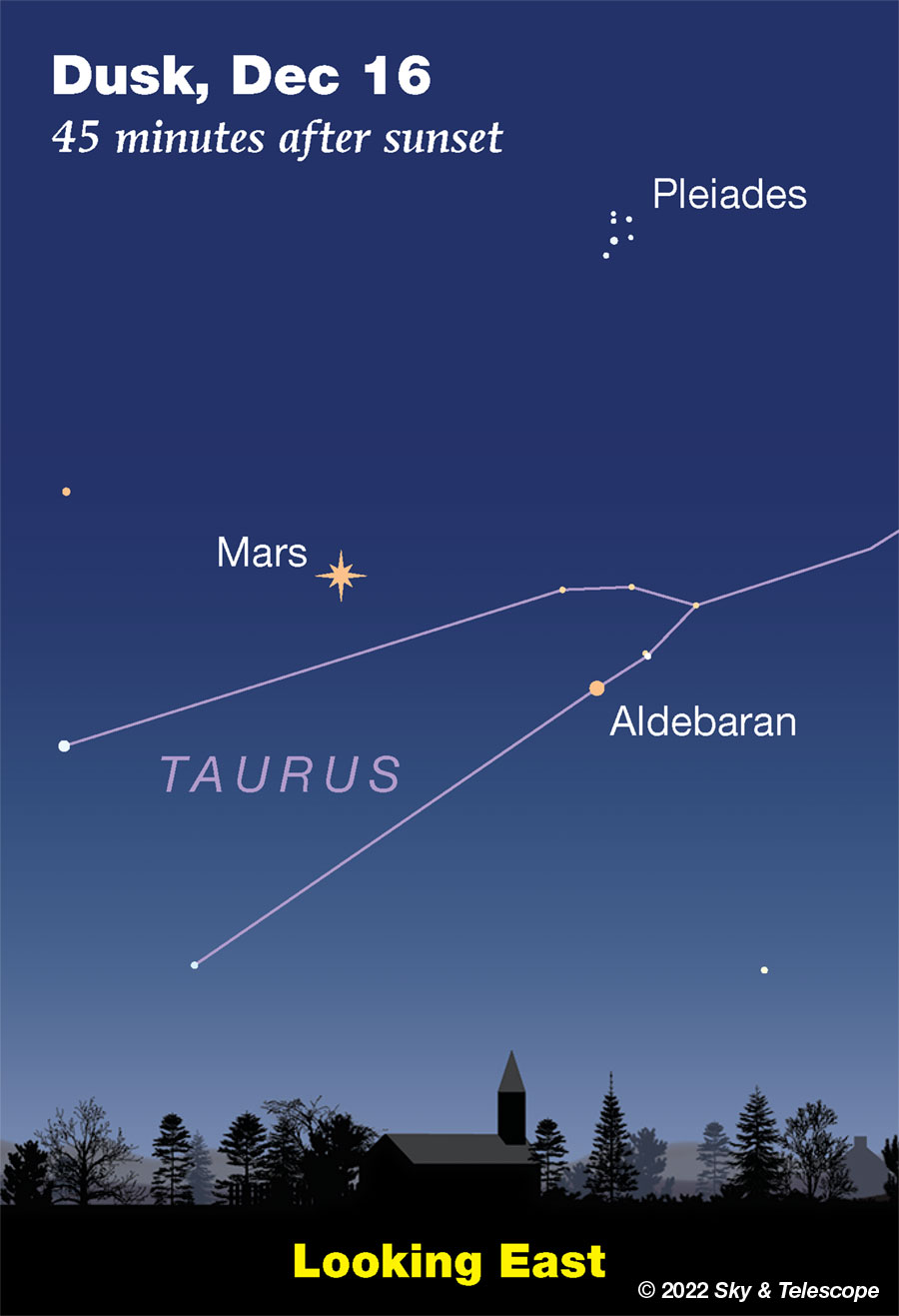
SATURDAY, DECEMBER 17
■ Have you ever watched a Sirius-rise? Find an open view right down to the east-southeast horizon, and watch for Sirius to come up about two fists below Orion's vertical belt. Sirius rises sometime around 8 p.m. now, depending on your location.
About 15 minutes before Sirius-rise, a lesser star comes up barely to the right of there: Beta Canis Majoris or Mirzam. Its name means “the Announcer,” and what Mirzam announces is Sirius. You’re not likely to mistake them; the second-magnitude Announcer is only a twentieth as bright as the king star soon to make his entry.
When a star is very low it tends to twinkle slowly, and often in vivid colors. Sirius is bright enough to show these effects well, especially with binoculars.
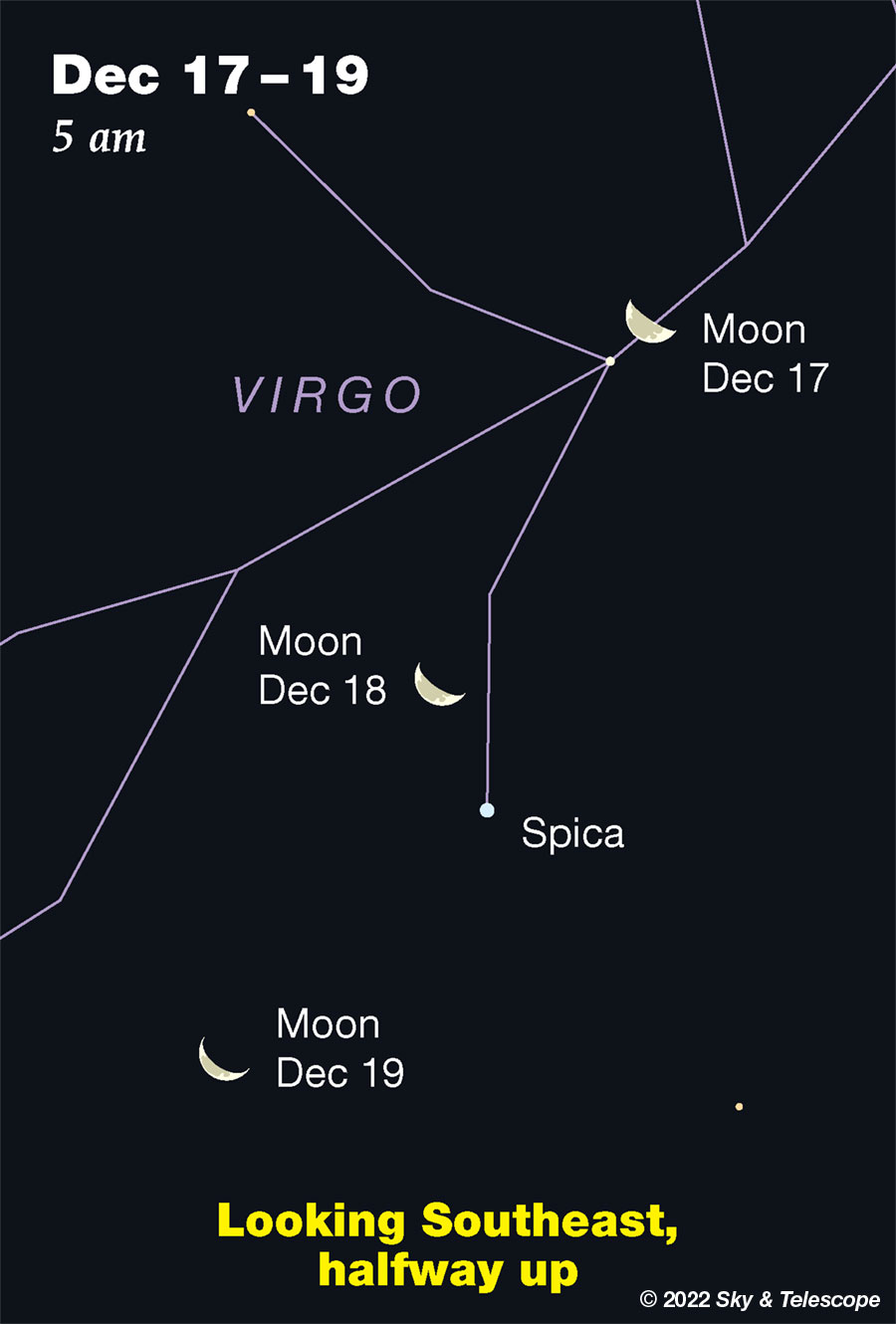
SUNDAY, DECEMBER 18
■ This is the time of year when M31, the Andromeda Galaxy, passes your zenith soon after dark (if you live in the mid-northern latitudes). The exact time depends on your longitude. Binoculars will show M31 just off the knee of the Andromeda constellation's stick figure; see the big evening constellation chart in the center of Sky & Telescope.
Lie on your back with the binocs and look straight up. M31 crosses smack through your zenith if you're at 41° north latitude.
MONDAY, DECEMBER 19
■ After the Pleiades and Hyades, what's the next most attractive star cluster in Taurus? Maybe it's big, loose NGC 1647, between the horns of Taurus just a few degrees from Aldebaran and the Hyades. Matt Wedel, Sky & Telescope's Binocular Highlights columnist, calls it "a wonderful object for binoculars," but that's in a really dark sky.
The cluster's location, at least, is easy: It forms a not quite equilateral triangle with Aldebaran and the other tip of the Hyades V. (The cluster is centered 1° southeast of, i.e. currently below, the point that would make the equilateral triangle perfect.) Just off the cluster's south edge you'll find "a fine optical double star," Matt writes, very wide and unequal, both orange, magnitudes 6.0 and 7.5.
Some, however, would instead give the rank of third-place Taurus cluster to the NGC 1746 complex, also between the Taurus horns. It's larger, sloppier, and a little more photogenic and eye-catching. Look for it 3/5 of the way from Aldebaran to Beta Tauri. (NGC 1647 is 1/5 of the way along that same line.)
NGC 1746 and 1647 often get confused, not least because their NGC numbers are the same digits swapped.
And in fact, what gets called "NGC 1746" is actually a rough, messy superposition of three distinct loose clusters. No wonder it looks big and lopsided.
TUESDAY, DECEMBER 20
■ Around the end of twilight, face north and look very high. Cassiopeia is now a flattened M shape there, canted at about a 45° angle (depending on where you live). Just two hours later, the M is horizontal! Constellations passing near the zenith appear to rotate rapidly with respect to your direction "up."
■ You are remembered, Carl Sagan (November 9, 1934 – December 20, 1996).
WEDNESDAY, DECEMBER 21
■ Jupiter's Great Red Spot should transit the planet's central meridian around 8:59 p.m. EST. A light blue or green filter at the eyepiece helps a bit.
Features on Jupiter are nearer to the central meridian than the limb for 50 minutes before and after they transit.
THURSDAY, DECEMBER 22
■ The Summer Triangle sinks lower in the west as evening proceeds, and Altair is the first of its stars to go (for mid-northern skywatchers).
Start by spotting bright Vega, magnitude zero, the brightest star in the northwest soon after dark. The brightest one above Vega is Deneb. Altair, the Triangle's third star, is farther to Vega's left. How late into the night, and into the advancing season, can you keep Altair in view?
■ On the opposite side of the sky, Orion shines in the east-southeast after dinnertime. He's well up now, but his three-star Belt is still nearly vertical. The Belt points up toward Aldebaran and, even higher, the Pleiades. In the other direction, it points down to where bright Sirius will rise around 7 or 8 p.m. to twinkle furiously.
FRIDAY, DECEMBER 23
■ Above Orion shines orange Aldebaran with the large, loose Hyades cluster in its background. Binoculars are the ideal instrument for this cluster given its size: its brightest stars (4th and 5th magnitude) span an area about 4° wide. (Fainter ones extend much farther.) Higher above, the Pleiades are only a little more than 1° across counting just the brightest stars.
The main Hyades stars famously form a V. It's currently lying on its side, open to the left. Aldebaran forms the lower of the V's two tips.
With binoculars, follow the lower branch of the V to the right from Aldebaran. The first thing you come to is the House asterism: a pattern of stars like a child's drawing of a house with a peaked roof. The house is currently upright and bent to the right like it got pushed.
The House includes three binocular double stars that form an equilateral triangle, with each pair facing the others. The brightest pair is Theta1 and Theta2 Tauri. You may find that you can resolve the Theta pair with your unaided eyes.
■ New Moon (exact at 5:17 am EST on this date).
SATURDAY, DECEMBER 24
■ Starting 20 minutes after sunset, use binoculars to look low above the southwest horizon for Venus. Once you get it, watch for Mercury 4° to its upper right (well less than a binocular field width), and a very thin fingernail clipping of a crescent Moon a similar distance to Mercury's lower right. See the scene below.
The Moon is only 1½ days old when seen from the longitudes of the Americas. Can you see the earthshine on the Moon's dark portion?
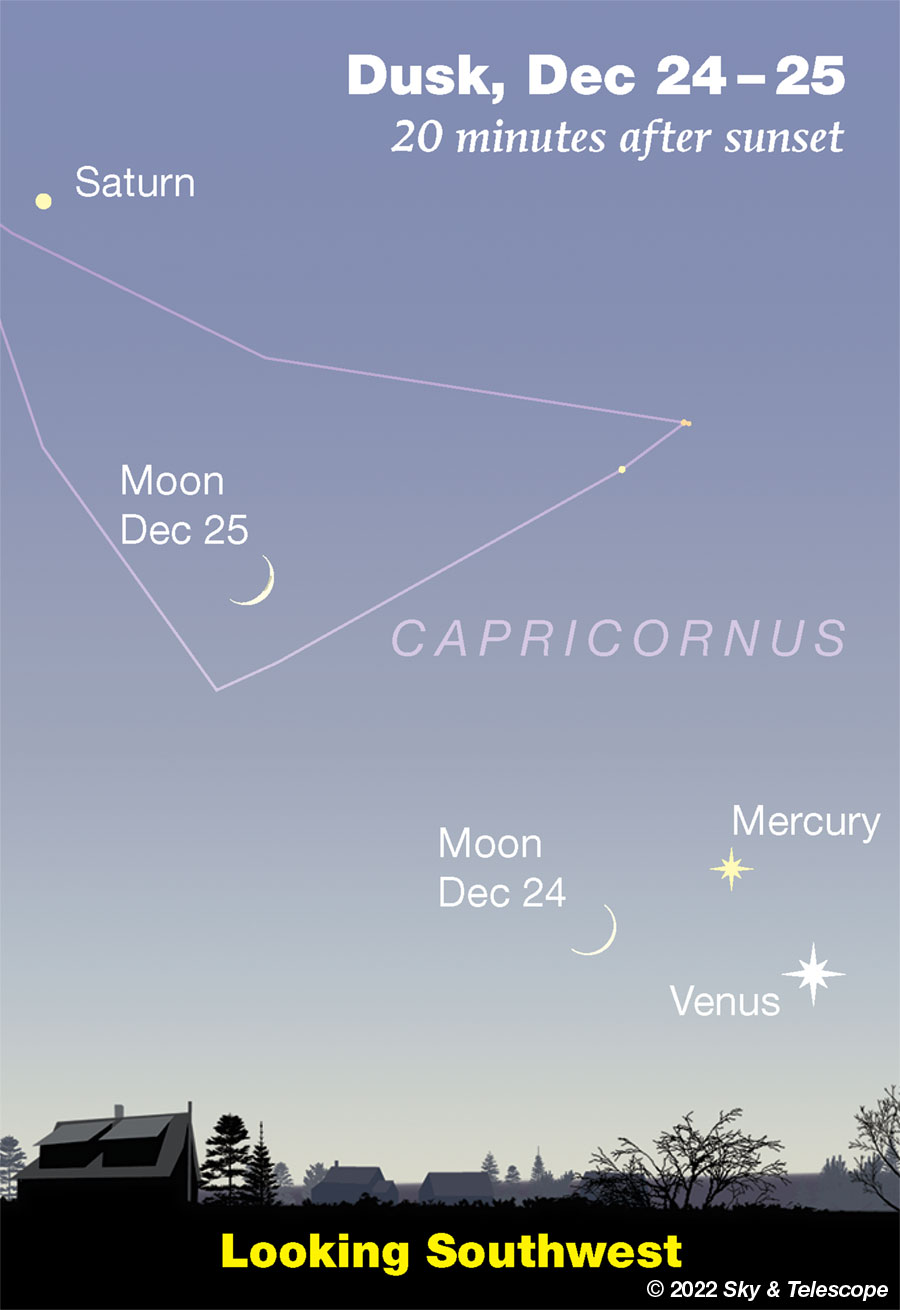
■ Writes Gary Seronik in the December Sky & Telescope, "Enjoy some extra holiday cheer [soon after dusk] courtesy of a 90° string of lights. It includes, from south to west-northwest, Fomalhaut, Saturn, Altair, and Vega. The quartet are similarly bright — only a touch more than a magnitude distinguishes the brightest light in the string (Vega) from the faintest (Fomalhaut)." They're about equally spaced.
This Week's Planet Roundup
Mercury and Venus glimmer very low in the southwest in bright twilight. Try for them with binoculars 20 or 30 minutes after sundown. Venus is by far the brightest at magnitude –3.9. Mercury, about 5° to Venus's upper left all week, is only mag –0.6. They both get a little higher and easier day by day.
Mars fades a bit from magnitude –1.7 to –1.5 this week as it recedes from opposition, and it shrinks from 16.4 to 15.2 arcseconds wide. It shines like a firespark in the east as the stars come out. It gains altitude until culminating nearly overhead around 10 or 11 p.m. Mars still outshines Sirius (which rises around 8 p.m.). Mars's fiery yellow-orange color always helps give it away.
Mars is between Aldebaran to its lower right in the evening, and Capella almost three times as far to Mars's upper left. The planet passed exactly between them on December 14th, moving west. Watch it creep farther out of this alignment day by day. It will reverse and go back directly between these stars in February. Bonus points: Can you say why? Answer at the bottom of this page.*
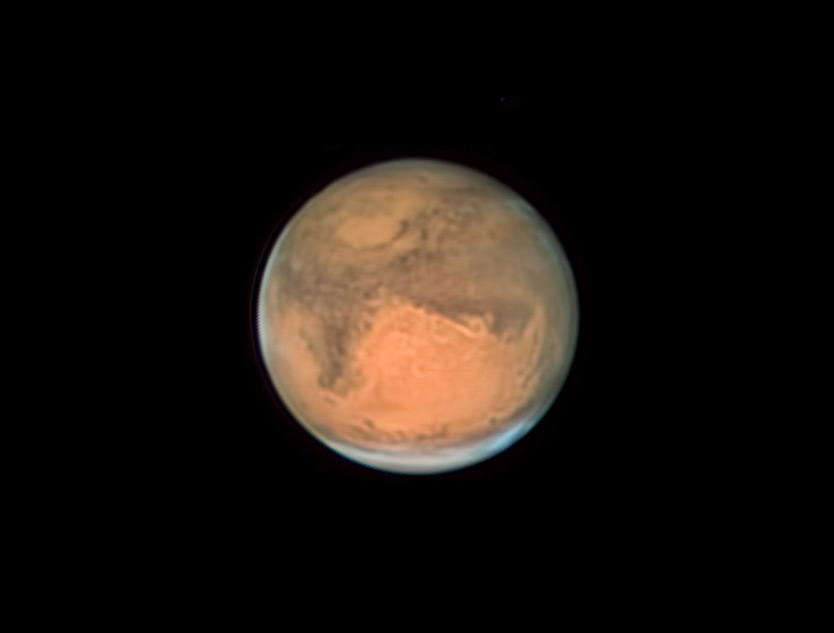
Jupiter blazes white high in the south in twilight, then sinks toward the southwest. At magnitude –2.5 it vastly outshines the background stars of dim Pisces. Look for the Great Square of Pegasus above it as the stars come out, and upper right of Jupiter as the evening advances.
Telescopically, Jupiter is down to 41 or 40 arcseconds wide.
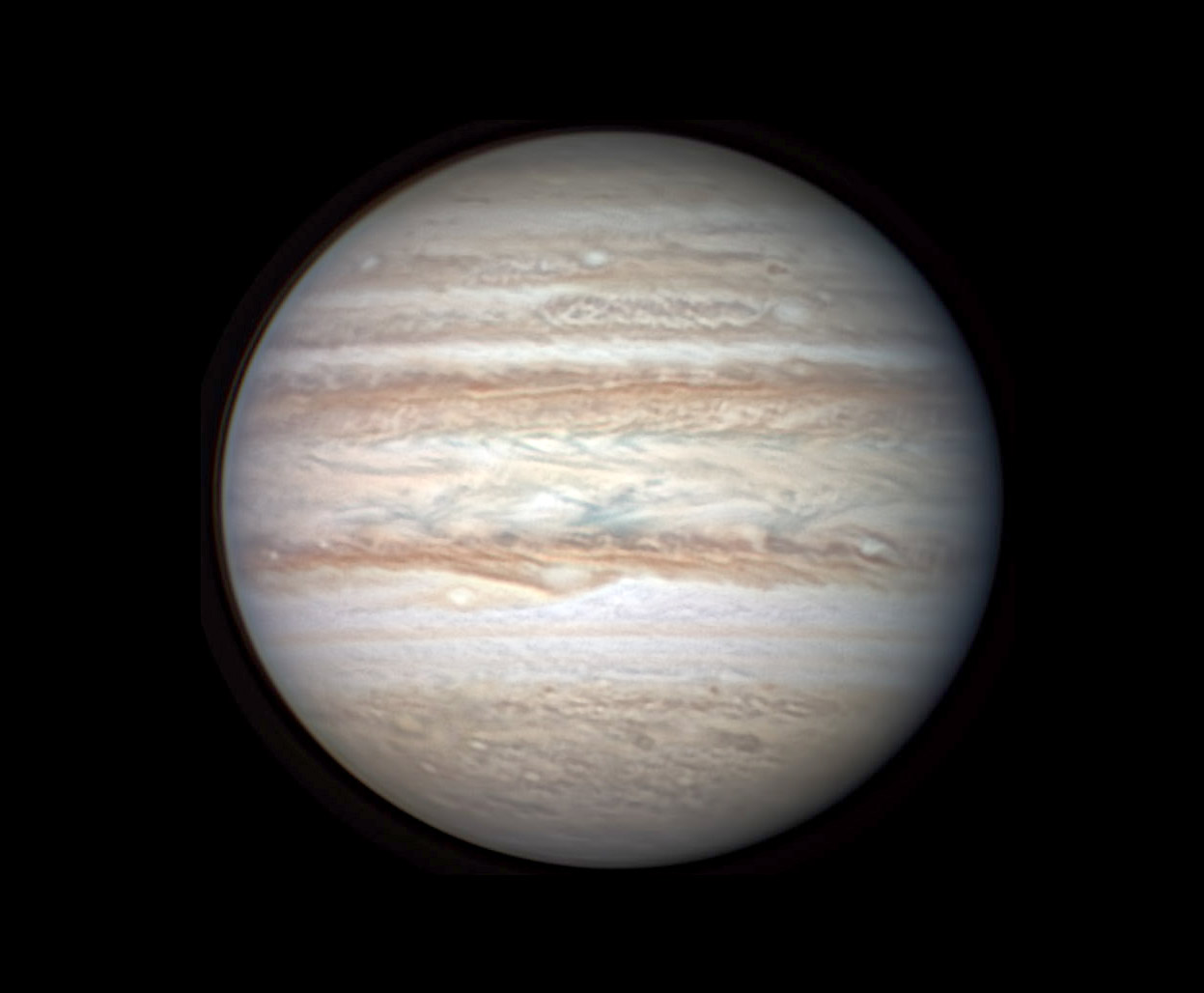
Here on the non-Red-Spot side of Jupiter, notice the big, brownish arch hanging down from the North Equatorial Belt. This high-resolution image shows that the arch surrounds a gray oval. Visually, even with a telescope this big, all you may be able to see of the arch is an unusual bump on the belt's north side. More such arches have appeared on the other side of the planet. From the NEB's south side, blue festoons trail into the Equatorial Zone. Bluish areas are gaps in the clouds, allowing us to see deeper down through Jupiter's blue-sky hydrogen air.
Saturn, magnitude +0.8 in Capricornus, glows in the southwest as twilight fades to night. Left of it, by two fists at arm's length, sparkles Fomalhaut. Catch Saturn as early as you can; it sets around 8 or 9 p.m.
Uranus, magnitude 5.7 in Aries, moves high across the south during evening. It displays a tiny, very slightly blue-greenish gray disk 3.7 arcseconds wide. It a telescope at high power it's obviously non-stellar. See the Uranus finder charts in the November Sky & Telescope, page 49.
Neptune, magnitude 7.9 at the Aquarius-Pisces border about 7° west of Jupiter, is getting lower in the evening. It's just 2.3 arcseconds wide, again non-stellar in a telescope but requiring more effort than Uranus. It's slightly bluish gray, if you have enough aperture to show color at all in something this faint. See the Neptune finder charts in the September Sky & Telescope, page 49.
All descriptions that relate to your horizon — including the words up, down, right, and left — are written for the world's mid-northern latitudes. Descriptions and graphics that also depend on longitude (mainly Moon positions) are for North America.
Eastern Standard Time (EST) is Universal Time minus 5 hours. Universal Time is also called UT, UTC, GMT or Z time.
Want to become a better astronomer? Learn your way around the constellations. They're the key to locating everything fainter and deeper to hunt with binoculars or a telescope.
This is an outdoor nature hobby. For an easy-to-use constellation guide covering the whole evening sky, use the big monthly map in the center of each issue of Sky & Telescope, the essential magazine of astronomy.
Once you get a telescope, to put it to good use you'll need a detailed, large-scale sky atlas (set of charts). The basic standard is the Pocket Sky Atlas (in either the original or Jumbo Edition), which shows stars to magnitude 7.6.

Next up is the larger and deeper Sky Atlas 2000.0, plotting stars to magnitude 8.5; nearly three times as many. The next up, once you know your way around, are the even larger Interstellarum atlas (stars to magnitude 9.5) or Uranometria 2000.0 (stars to magnitude 9.75). And be sure to read How to Use a Star Chart with a Telescope. It applies just as much to charts on your phone or tablet as to charts on paper.
You'll also want a good deep-sky guidebook. A beloved old classic is the three-volume Burnham's Celestial Handbook. An impressive more modern one is the big Night Sky Observer's Guide set (2+ volumes) by Kepple and Sanner.
Can a computerized telescope replace charts? Not for beginners, I don't think, and not on mounts and tripods that are less than top-quality mechanically, meaning heavy and expensive. And as Terence Dickinson and Alan Dyer say in their Backyard Astronomer's Guide, "A full appreciation of the universe cannot come without developing the skills to find things in the sky and understanding how the sky works. This knowledge comes only by spending time under the stars with star maps in hand."
![]() Audio sky tour. Out under the evening sky with your
Audio sky tour. Out under the evening sky with your
earbuds in place, listen to Kelly Beatty's monthly
podcast tour of the heavens above. It's free.
"The dangers of not thinking clearly are much greater now than ever before. It's not that there's something new in our way of thinking, it's that credulous and confused thinking can be much more lethal in ways it was never before."
— Carl Sagan, 1996
"Facts are stubborn things."
— John Adams, 1770
*Answer to why Mars reverses direction. All the planets move eastward against the background stars most of the time. That's because that's the direction the planets orbit around the Sun. But, so does Earth. Because we orbit faster than the outer planets do (since we're closer to the Sun), when we are between the Sun and one of them, it appears to us to move backward against the stars for a while. That is, westward.
This is called their "retrograde loop." It gave fits to the pre-Copernican astronomers who assumed that Earth was obviously motionless and the center of everything. It fell right into place when Copernicus realized the Earth it a moving planet too.
 12
12









Comments
Rod
December 16, 2022 at 10:36 pm
I did get out and enjoy some telescope time this evening.
Observed 2015-2145 EST. Last Quarter Moon 16-Dec-2022 0856 UT. I enjoyed some telescope time tonight looking at Mars, M45 (Pleiades), and M45 in Orion. Low power views for M45 and M42 using TeleVue 32-mm plossl at 31x. Higher power views using TeleVue 9-mm Nagler with TeleVue 1.8x Barlow lens for 200x observations of Mars. Mars still a good sight in the 90-mm refractor telescope using #23A red filter. The Sky & Telescope Mars Profiler tool showed central meridian longitude 107 degrees at 2021 EST. Some of the dark surface areas shown visible at 200x with #23A red filter. Stellarium 1.1 shows Mars about 16.42 arcsecond angular size tonight. The Pleiades looked lovely and M42, always a spectacular sight. Much nebulosity and arc visible with the Trapezium stars. 4 Trapezium stars easily visible along with the great nebula arc. Yesterday about 1.8-inches of rain moved through so fields very wet tonight, I stayed on a paved area with a number of outdoor Christmas lights lit up. It was an enjoyable way to pass the time tonight. Temperature 3C, mostly clear skies, winds 280/5 knots.
You must be logged in to post a comment.
Stoney
December 17, 2022 at 10:00 am
I have viewed this website before and it has always piqued my interest. I have always been fascinated with stars and planets and all that cool stuff in outer space! My fiancee and I have been together for over 14 years and very happy years together through and through. She knew I always wanted a telescope. She just recently bought me one and I am just so happy about it! It is probably not what most skywatchers consider top notch but I am not sure. It is a good one for beginners like me we are told. I don't know much about telescopes at all. Any tips or advice would be greatly appreciated! Hope your day is blessed!
You must be logged in to post a comment.
Musicjack999
December 18, 2022 at 6:33 pm
I was able to observe Venus easily without binoculars about 1/2 hour after sunset here in Lady Lake. Fl. A few wispy clouds hid Mercury. Maybe tomorrow night.
You must be logged in to post a comment.
misha17
December 18, 2022 at 7:19 pm
Spaceweather is reporting that Comet 29P Schwassmann-Wachmann will occult a 12th magnitude star as seen from Southern California around3:45am early Monday Dec19th, i.e. in a few hours from now.
Source:
https://spaceweather.com/index.php
You must be logged in to post a comment.
Rod
December 19, 2022 at 6:12 am
misha17, if you can observe let us know, thanks. The waning crescent Moon in Virgo this morning near and after 0600 EST is very lovely with much earthshine visible. I viewed unaided eyes and with 10x50 binoculars. Virtual Moon Atlas reports angular diameter ~ 31.93 arcminutes. Temperature here -3C with west winds 5 knots. Beautiful clear skies here.
You must be logged in to post a comment.
misha17
December 21, 2022 at 2:49 am
I don't have a telescope, but this article has observation reports:
https://britastro.org/section_information_/comet-section-overview/mission-29p-2/mission-29p-centaur-comet-observing-campaign
You must be logged in to post a comment.
Rod
December 20, 2022 at 6:06 am
Another lovely waning crescent Moon in Libra this morning with much earthshine 🙂 The ISS passed by Ursa Minor and Draco, stopping by for a visit at my place 🙂 Clear skies temperature -4C.
You must be logged in to post a comment.
mary beth
December 21, 2022 at 1:26 pm
That was actually Santa Claus! Merry Christmas Rod!
You must be logged in to post a comment.
Rod
December 22, 2022 at 6:38 am
That is a good one! Stellarium 1.1 claimed it was the ISS I could see 🙂 Moving towards NE so perhaps Santa Claus for sure to a trial run for Christmas Eve 🙂
You must be logged in to post a comment.
Rod
December 21, 2022 at 6:40 am
Well, another lovely waning crescent Moon rising in Scorpius this morning. Moon rises at my location about 0520 EST according to Virtual Moon Atlas, about 0522 EST, Starry Night. Another beautiful, clear sky with temperature -5C. Hope others are enjoying these early Moon views in the morning. The lunar angular size about 32.79 arcminutes and about 5.4% illuminated.
You must be logged in to post a comment.
mary beth
December 21, 2022 at 1:34 pm
Festive Winter Greetings, Merry Christmas, Happy Hanukkah and Holidays to all! Great to see so many posts and new faces! Hope everyone stays warm and safe during the Arctic wx!
Quick question - some websites say that winter arrives at 3:47 CST, but I’ve also seen 3:38 and 3:49. Is there a slight variance by location? It seems like it would be at the same time worldwide.
You must be logged in to post a comment.
misha17
December 23, 2022 at 12:18 pm
So when was the Solstice?
You must be logged in to post a comment.
You must be logged in to post a comment.